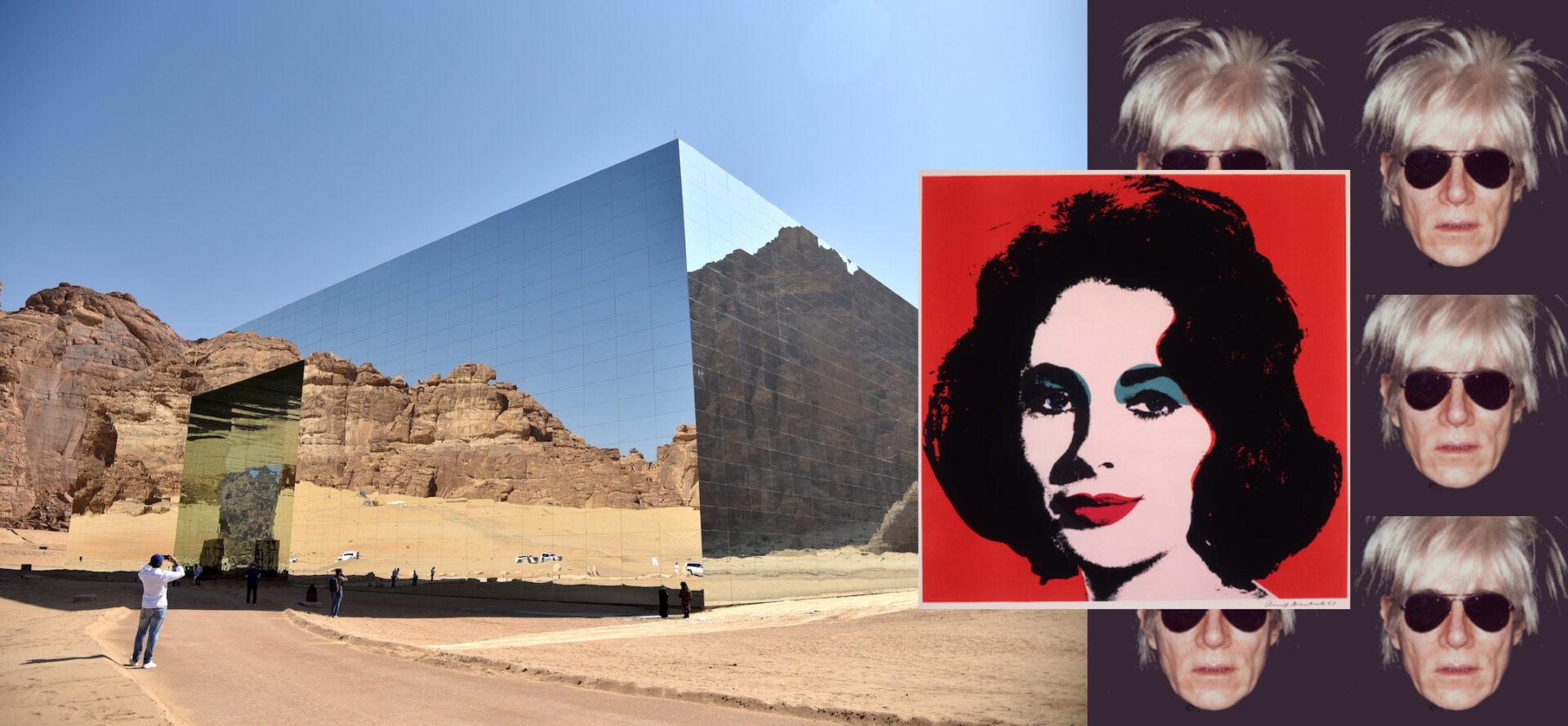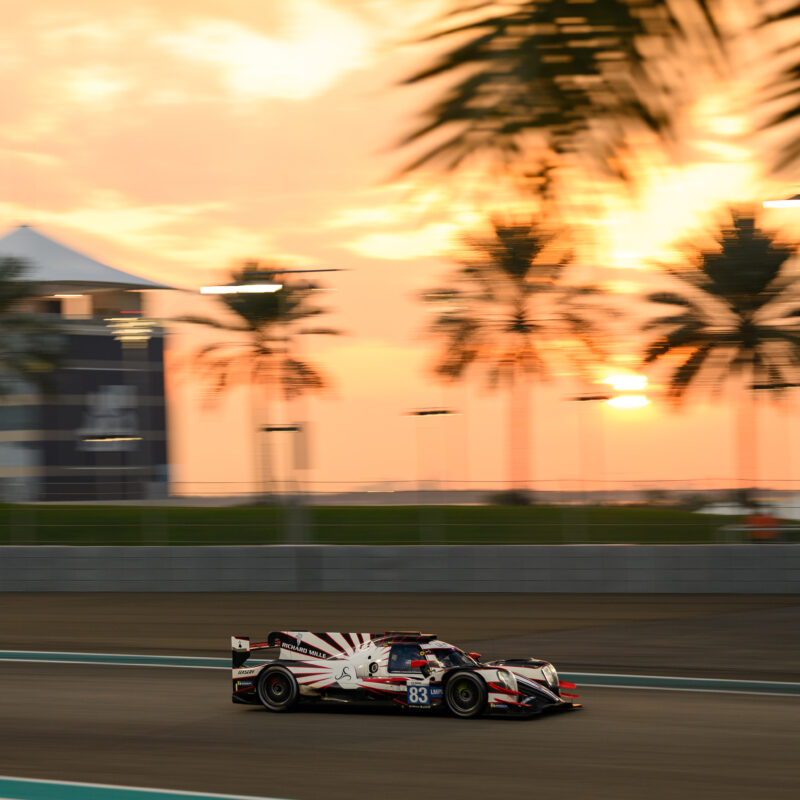
WANG HAIZOU/XINHUA VIA GETTY IMAGES; ANDY WARHOL MUSEUM
Saudis aim to show cultural change with Warhol exhibition at desert arts site
Display of iconic ’60s artist’s works brings celebrities to glittering premiere amid criticism that his gay life is unexplored
ALULA, Saudi Arabia – In a white-cubed gallery space, like one that could be found in New York or London, a multitude of metallic balloons float like pillows in space while visitors come to play joyfully with the installation: Andy Warhol’s 1966 work “Silver Clouds.” It would have been a spectacle common in any major world capital with a bustling contemporary art scene had it not been for the fact that the gallery was stationed in the mirror-clad Maraya Concert Hall in AlUla, Saudi Arabia’s ancient desert region here, and that this was Andy Warhol’s first-ever show in the kingdom.
The reveling spectators, a mix of international visitors mingling with local Saudi men and women in traditional dress, revealed a fascinating scene — one largely unthinkable prior to around 2016. That was when Crown Prince and Prime Minister Mohammed bin Salman unveiled Vision 2030, his grand reform agenda to wean his country off a reliance on oil through investment in creative entrepreneurship, innovation, tourism and implementing wide sweeping social change.
Warhol’s balloons shine with glamor akin to that of the Maraya Concert Hall, which earned a Guinness World Record in 2020 as the largest mirrored building in the world; the concert hall is a standout feature of the area, about 700 kilometers (435 miles) north of Jeddah, which until around 2020 was barely visited by either locals or foreigners, as it vies to become a global art hub for art and culture.
The playful balloons are part of the exhibition “FAME: Andy Warhol in AlUla,” which is part of the second edition of the AlUla Arts Festival (Feb. 16-28). The Warhol show, which runs through May 16, offers a unique look at the renowned 21st-century American Pop artist known as a great disruptor for his spirited works that seamlessly appear to defy categorization, freely occupying both artistic, documentary and commercial artistic genres yet belonging to neither. They are on view alongside Warhol’s notorious portraits of Muhammad Ali, Salvador Dali, Bob Dylan, Dolly Parton and Elizabeth Taylor, among others.
“I thought it would be quite intoxicating to stage a Warhol exhibition in AlUla due to the combination of extraordinary natural wonders combined with the growth of the contemporary art scene here,said Patrick Moore, director of The Andy Warhol Museum in Pittsburgh, who curated the exhibition. Moore said the show was conceived after he was invited to AlUla on a trip in 2021. “There is a certain sameness to everything at times in the art world, and I thought it would be interesting to do something here in this place that is so physically dramatic and beautiful,” he told The Circuit. “I was quite taken with Maraya, which seemed to be the perfect metaphor for Warhol — this giant mirrored building that reflects whatever it is surrounded by.”
Inside the Maraya Concert Hall in a series of makeshift white gallery spaces hang 70 iconic works by the artist who is considered to be one, if not the, defining artist of the 21st century. The show looks at Warhol’s legacy through works that focus particularly on his obsession with fame, stardom and celebrity through images of some of the most famous names of the times, coupled with shots of more anonymous personages who also serve as counterculture icons themselves through their rendering by Warhol. For example, the first room presents the artist’s series of “screen tests,” or filmed black-and-white portraits, of visitors to Warhol’s infamous New York City studio known as The Factory. There’s a film of Lou Reed, a founding member of The Velvet Underground rock band slowly drinking a glass of Coca-Cola while wearing thick-rimmed black glasses as if he had no cares in the world. There are also shots of actress Mary Woronov, who studied at Cornell University before appearing in her first Warhol film, “Hedy,” in 1985. She later became a performer in Warhol’s live multimedia show the “Exploding Plastic Inevitable,” which also featured the Velvet Underground. She was also featured in Warhol’s 1966 film “The Chelsea Girls.”
Despite the fanfare and the large group of international VIP guests and press — many journeying to AlUla for the first time, political and social tensions around staging the exhibition in Saudi Arabia still permeated the ambiance. Before the show’s opening, Western media pointed out that Warhol was overtly gay and how Saudi Arabia still carries harsh sentences — including the death penalty — for homosexuality.
Yet Moore, like his Saudi counterparts at the Royal Commission for AlUla (RCU) who staged the show, urged visitors to focus on Warhol as the artist and not on his personal life. The show, Moore stressed to The Circuit, is not about his sexuality; it is about his fascination with fame and celebrity that so defined his work throughout his life. “Not every exhibition of Warhol needs to focus on the fact that he was a gay artist,” Moore added. Instead, the works in the show were carefully tailored to the audience that would view them in AlUla: there are no controversial works in the show. In many ways the exhibition is a strong yet concise introduction to Warhol’s most iconic works for a public that perhaps is not as familiar with the artist’s legacy.
In many ways, this is the mission now of RCU for the growth of the art scene in AlUla: to make it as focused on local Saudi and regional art as it is international contemporary artists.
The show is part of the second edition of the AlUla Arts Festival, which comprises exhibitions of local and regional art throughout AlUla, including the second showing of the AlUla Artist Residency, which stages specially commissioned works by six international artists, largely from the Middle East, within a lush tranquil oasis. There’s also the Madrasat Addeera, a former girls’ school in AlUla that is now offering 70 local Saudi women free education in local artists in crafts through the Prince’s Foundation School of Traditional Arts.
“It’s not about buying a souvenir from AlUla: we are trying to foster a creative economy through the encouragement of a local artistic community,” Nora Aldabal, arts and creative planning director for the Royal Commission of AlUla, told The Circuit. “After four years we are seeing the increase in quality of works created at [Madrasat Addeera]. These pieces are serving to build the economy through the preservation and growth of our local crafts.”
In tandem with fostering local talent, like with the Warhol show, RCU is trying to appeal to the international world in a bid to become a global arts hub where artists and creatives can come to be inspired and create work in AlUla that stems from a particular dialogue with the local landscape. Aldabal confirmed that RCU would also soon be establishing a contemporary art museum focusing on the intersection between regional and international art. As she put it: “We want to serve as a window for Saudi to the world, and a window for the world into Saudi Arabia.”


